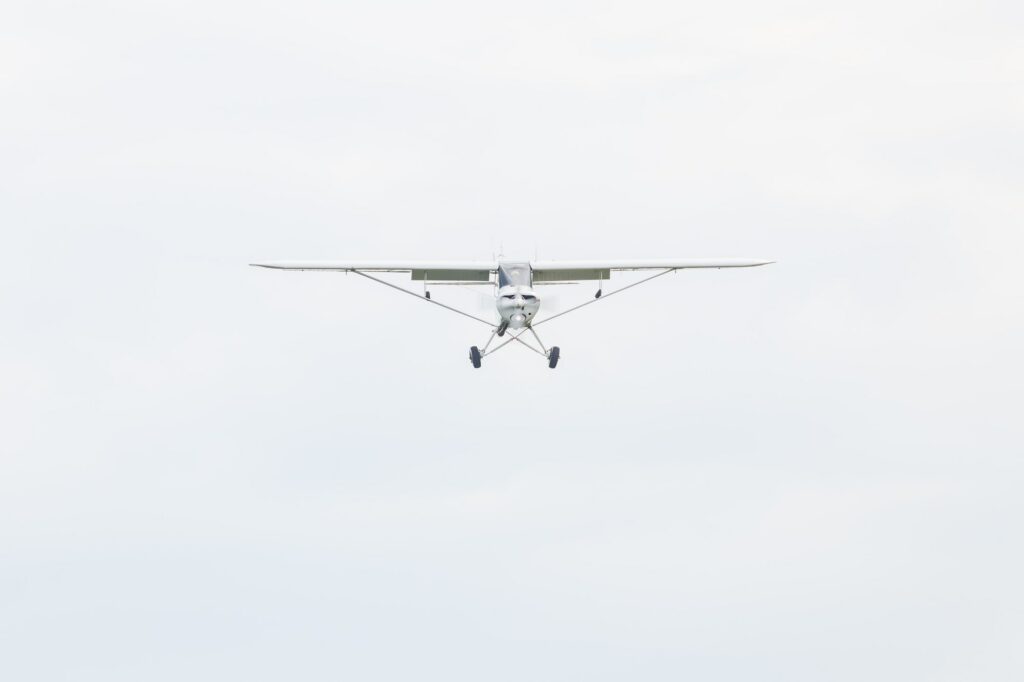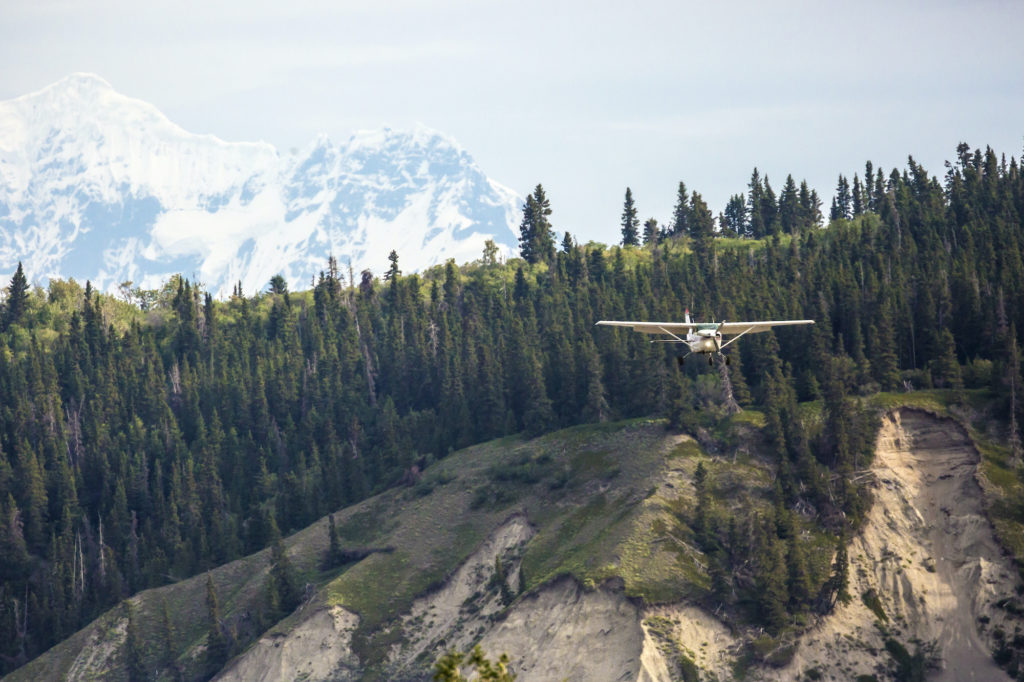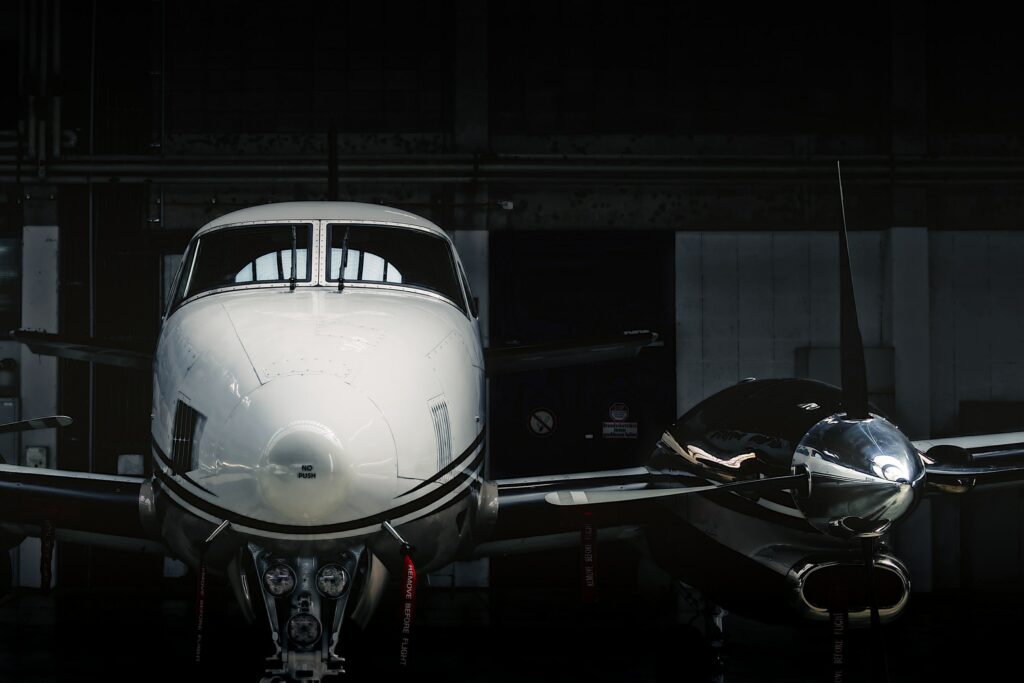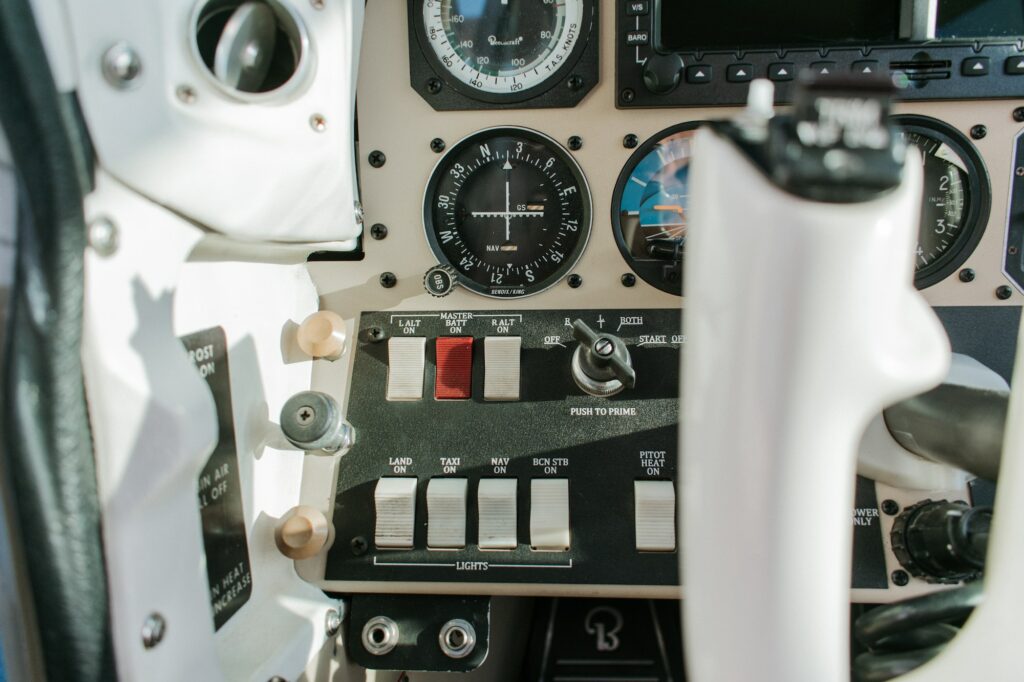
Learn to Fly In Ten Minutes
Learn to Fly In Ten Minutes
Let’s skip the details, and discuss the basics of flying airplanes. This is our Private Pilot Ground School condensed into a ten-minute read.
The Rules of Aviation
When it’s said and done there’s only a few big rules in aviation:
- Don’t hit anything
- Don’t make rule-making folks mad
- Train and fly in a way that ensures you obey rules one and two
This journey can get complicated and confusing, but almost all of it comes back to these key principles.
Moving on…
Why Even Fly?
Flying small airplanes comes with risk. It’s not as safe as driving a car. It’s about as safe as riding motorcycles.
Unlike with motorcycles, most of the risk comes from us and not other people. That’s the good news. If we do it right, we choose our own level of safety.
If flying can be dangerous, why do we do it?
Well, for folks that love flying it’s fun. Not like a theme park or a night at the club is fun. More in a sets-your-soul-right kinda way. This isn’t true for everyone (and it doesn’t have to be) but for a lot of folks flying is a part of them.
Flying is also a really great means of transportation, depending on your timeframe and distance you need to fly. It’s not always great for going fifty miles to a business meeting in questionable weather. Need to get from Los Angeles to Korea by tomorrow? Flying is pretty sweet.
But ultimately, most of us fly because we love it. And most people who get good at flying do it because they love it.
If you are thinking about flying because you heard the pay is good (not quite so simple!) or the travel is amazing (again, not so simple!), or you really like the idea of a fancy plastic blue-green card from the FAA that says you are, in fact, a pilot, you may not be the right student for this course, or for flying in general. If you are not interested in flying, it is likely not worth the effort.
That said, if you’re excited about flying you are in good company! We love it. And we really want you to love it too. We also want you to be safe, skilled, and continue improving as a pilot for as long as you fly.
Pilots (Oh, The Personalities You’ll See!)
Pilots are an interesting bunch. Most are nothing like the Hollywood stereotype.
The ideal pilot is a dichotomy:
- Confident but not cocky
- Humble but not nervous
- Able to consider details without losing track of the big picture
- Friendly but internally motivated
- An independent thinker but also a team player
As you continue your training keep your eye out for pilots worth emulating. None of them are perfect, so you can even find individual characteristics of different pilots that are worth emulating.
Now that we’ve got that out of the way, let’s talk about flying.
Rule 1 of Flying: Don’t Hit Anything
This one feels pretty explanatory. It’s highly advised that you refrain from slamming your airplane into any of the following:
- Dirt
- Mountains
- Houses
- Lakes/Rivers/Oceans
- Other Airplanes
- Nursing Homes
- Orphanages
This sounds pretty easy, but it’s not so simple. Far from it, in fact. There are aerodynamic mistakes that can cause you to slam into the ground. There is weather you can fly into that, even with the best flying skills in the world, you will not be able to get out of. Part of respecting this rule is being good at flying airplanes. The other part is making good decisions. You must have both, or you won’t have either for very long.
Even then, sometimes very good pilots hit something. The other part of this rule is the humility to recognize that everyone makes mistakes. Our energy should not be spent looking down on pilots who made mistakes, but rather learning from those mistakes so that we are not next.
Lastly, if you must hit something with an airplane, it’s highly advised that you do so in the most horizontal manner possible, and ideally in a way that keeps you upright. Your organs are much better at absorbing horizontal impacts than vertical ones.
Rule 2: Don’t Make Rule-making Folks Mad
To underscore the importance of not hitting things, the government has made a lot of rules. New rules are usually added in response to folks, well… running into things.
It’s a good idea to comply with the government’s rules. Mostly because those rules exist for a reason, but also because the government can take away your flying privileges.
Rule 3: Airmanship
Rule three is how you accomplish the other two rules.
Almost nobody who crashes into a mountain plans to do it. It’s a result of lapses in judgment, confusion, lack of planning, and sometimes a little bad luck. This is, again, not an indictment of folks who’ve been lost in airplane crashes. Better pilots than us have. It’s simply a statement of fact.
Airmanship is the combination of skill, effort, knowing, and caring that you bring to your flying. It’s the attitude you have, the way you study, the conservative decisions you make, and the systems you make and follow to ensure your very best effort to uphold the two rules of flying.
Airmanship is a bit like love in Paul’s first letter to the Corinthians. If you have talent, and hard work, and luck, but have not airmanship…
Much like love, airmanship involves caring, and a degree of piety.
Airmanship is very hard to pinpoint and define, and as a result it’s often overlooked in training programs. We think that’s a shame. Our goal through this program is to relate our learning back to airmanship through every step of the process, as best we can.
Air & Airplanes
By far the best way to get into trouble in an airplane is to have no idea how the air moves around your machine.
Airplanes work by moving air over a wing, which creates lift. How precisely this happens is, surprisingly, still somewhat contested at the high levels. But in the simple sense it’s mostly a combination of three things:
- The angle at which the air hits the wing
- The shape of the wing itself
- The speed of the air over the wing
Hold your hand flat out of a car window at highway speeds. You’ll notice that it is held up by the airflow. If you rotate the front of your hand up, the wind pushes it up further. If you rotate the other way, it pushes your hand down. That’s lift in action. The variable increases or decreases the lift generated is the angle at which the air hits your hand.
The faster we go, the smaller we have to rotate our hand to generate the same force.
Rotate your hand too far and the lift goes away—no matter how fast you’re going. Your hand just gets pushed backwards as the air hits your palm. When we angle a wing too far from the oncoming airflow, we stall. But, there’s good news! All we have to do is re-align the wing and we’re back in business.
Our flight controls allow us to change the angle at which our wings hit the air. And they work off this same basic principle. They allow us to create pressures on different parts of the airplane. Want to move the nose up? You’ll create a control pressure that pushes the tail down, and the nose up.
We can use this principle in other ways. Want to turn? To turn in an airplane, we first rotate it sideways. Through control pressures we’ll move one wing up and one wing down. Want to move the nose slightly right or left? Another control will create forces on the tail to do that. And so on.
When we turn, we roll the airplane sideways and let that lift from our wings move us sideways. It’s pretty sweet. Even though we are sideways relative to the ground, the force of the turn pushes us into our seat. With our eyes closed we’d hardly be able to tell we were turning.
In a very real way, the control that allows us to move the nose up and down also allows us to turn—we just have to roll over first. If we want to turn tighter, we move the controls just like we are bringing the nose up—except we’re sideways. If we move the controls too far, we stall, just like before.
When we want to land, we’re presented with a few issues. One is that we want to be relatively slow. The other is that sometimes the wind is blowing us sideways.
You see, when we’re in the wind it’s just like being in the current of a river. If you have a strong river current you may be swimming for the shore but you continue to move sideways down the river. The same is true in an airplane. The airplane doesn’t know it’s moving sideways until it’s time for the wheels to touch the pavement. Then it’s suddenly a bit of an issue. It turns out that wheels don’t like landing sideways.
If a strong wind is coming from the left, we have to face left a little to fly down the runway. If we pointed the nose straight down the runway we’d actually be flying drifting to the right.
But that means we’ll be sideways when we land. So, before we land we have to use the flight control to align the nose with the runway without drifting sideways. This is a crosswind landing and it’s a whole lot of fun.
Just about every airplane you’ve ever been in works this way—at varying levels of complexity and individual nuance.
Airplane Systems
In the last section we talked about the basics of how we fly an airplane. But the specifics will vary by the type of airplane we have. Just like some cars have 4WD and manual transmissions, and some have 2WD or automatic transmissions, not all airplanes are the same. You may know how to fly an airplane—but you better make sure you know how to fly your airplane.
Variances in airplane systems can alter everything from how you fly the airplane, to how you troubleshoot mechanical issues to how you slow down after landing. Knowledge of your airplane is critical. Applying a technique from one airplane to a different airplane is a great way to violate rule #1.
But ultimately all airplanes are operating under the same laws of physics.
Performance
Performance is a question of what we can make the airplane do in various environments. Examples of performance-related questions include:
- How much runway to do we need to take off and land?
- How quickly can we climb out of a layer of haze?
- How steeply can we climb over a mountain?
- How quickly can we roll?
- At what speed can we apply full control pressure without creating mechanical issues?
- How much passenger weight can we safely add?
- Where should we seat our passengers for maximum safety?
There’s a lot of questions there! Performance relies on three main actions:
- Knowing broad performance principles that apply to most airplanes
- Having the intelligence, forethought, and discipline to apply these principles 3. Knowing how to use performance charts to actually do the work
It’s very important to be comfortable calculating performance, because it’s the difference between a nice scenic climb and smacking into a pine tree at the end of the runway.
Weather
Weather presents a few issues for pilots, including:
- Making it hard or impossible see
- Creating situations that disorient pilots
- Wind conditions that make landing difficult
- The potential for airframe-damaging turbulence
- The potentiality of ice adhering to the airplane and making it un-flyable
For new pilots, weather education is focused on avoiding any kinds of low- visibility weather conditions. The highest risk for new pilots is not what the weather will do to you, it’s how you’ll get disoriented in the clouds and end up violating rule #1.
For more experienced pilots trained to fly on instruments alone, weather education is focused on avoiding dangerous conditions like turbulence and icing.
Navigation
Besides being really fun, flying can be a pretty good way to get around. But to do that, you need to figure out where you are and where you’re going. That is not quite as easy as it sounds.
A lot of us are used to driving around with GPS that directs our every turn. Pilots have a version of that too, but they ought not need it. In fact, at the beginning of training they ideally will not use such easy navigation methods. Pilots over- reliant on such technology are often referred to as “children of the magenta line” in reference to the typically magenta paths created by GPS systems.
There’s a few problems with being a child of the magenta line. Namely that if that magenta line stops working you don’t know where the hell you are. So, when we train new pilots we start with technologically-light methods of navigation. Using a magenta line is a privilege earned.
The simplest kind of navigation is called pilotage. It involves looking at a map, and then looking out of the window, and figuring out where you are and where you’re going. New pilots should be, first and foremost, good at pilotage.
After pilotage comes dead-reckoning. This involves doing math to select headings and times to get from place to place along a route. New pilots should be good at this too.
Then come the use of navigation systems—be it GPS or various ground-based radio navigation systems that help pilots move along a pre-determined path.
Airspace
As you’d imagine, the sky is pretty busy these days. To prevent too many airplanes from colliding into each other all the time, the air is separated into sections (named Alpha, Bravo, Charlie, Delta, Echo, and Golf) with different kinds of operating rules.
The classifications move up the alphabet as the airspace becomes more busy, or more necessarily regulated. Class G, for example, is the least controlled. It’s, in fact, the only airspace type considered uncontrolled—a term with a very specific meaning that we don’t have time for here. The rest are increasingly controlled. Class E is pretty much all over, except very low near the ground or in the boonies. Class D surrounds small, sorta busy airports. Class C the mid-size buys airports. Class B the very busy large airports. Class A is the airspace that most jets operate in as they cross the country.
There are six main types of airspace (A, B, C, D, E and G) in the United States, and another half-dozen types of airspace that overlap the main types.
For example, you may be practicing maneuvers in an area with Class E airspace, that also has a Military Operations Area (MOA) overlapping it. The MOA doesn’t get rid of the Class E, it’s just an extra designation in that section.
Pilots will need to learn to recognize what kinds of airspace they are in by looking at a map, and they’ll also need to memorize the various rules that they must comply with in that type of airspace.
Radio Work
One rule that exists in some types of airspace (but not all of them) is the requirement to talk to Air Traffic Control (ATC). ATC is a wonderful tool, but it’s critical to remember that controllers cannot fly your airplane for you. They are, however, a resource that you can use.
“It’s better to die than sound bad on the radio” is a common joke in pilot circles. But it’s a joke for a reason. Too many folks are worried about sounding good on the radio when they should be focused on learning to fly an airplane first.
The primary responsibility of ATC is keeping airplanes from hitting each other, especially airplanes that are operating in ways that don’t require them to look outside. Pilots who are able to see outside are responsible for looking around and not hitting things (literally, the principle is called “see and avoid”).
Rules, Rules & More Rules
So far we’ve mostly been talking about practical hands-on kinds of things. How to fly, knowing your airplane, calculating performance, and avoiding weather and other airplanes. A lot of the fundamentals of each of these skillsets is codified into the legal system. There’s a lot of rules. When we become pilots, we also become budget lawyers. If Saul from Better Call Saul had a budget lawyer, pilots would be that budget lawyer’s budget lawyer.
But, the rules exist for a reason. And you can get in a lot of unnecessary trouble by breaking them. So we learn them.
Largely, we try to adhere not only to the letter of the law, but to the spirit of the law as well. This is a a smart move not least of all because the FAA retains the right to a small section of the rule book that essentially says “being reckless is illegal”. So even if you didn’t break any other rules, if the rules folks decide that you were reckless, then you can still get in trouble. Best to be smart!
Advice for Future Pilots
First of all, we recommend leaving the social media at home. Learning to fly an airplane is not an environment well-suited to Instagram. It’s distracting, and far less important than the work you’re actually doing. Learning to fly an airplane also requires a degree of independence of thought and action that doesn’t lend itself towards people fixated on other’s opinions.
Secondly, learning to fly is wildly different than learning in school. You can’t fake your way through it, and if you try it will just make your life harder—and possibly shorter. You also can’t just learn to the test because you will actually need to know that information later. And if you know the information well, the test will be easy. So be prepared to adapt to a slightly different learning style, especially if you’re young and have limited non-school learning experiences to draw from. No shame—we are speaking from our own experience here.
Third, learning to fly is a lot like learning to play an instrument or a sport. You can conceptually understand the movements required, but until they are practiced repeatedly you will not be able to do it. A huge part of learning to fly is practicing again and again, even at home. We recommend that every student create a poster of the cockpit and rehearse procedures, including moving their hands and saying everything out-loud. It feels dumb, but it works. Not doing this is the #1 way that people waste a lot of good money in flight training. Doing this is the #1 way they succeed—even, perhaps especially—in faster professional programs in the airlines and military.
Lastly, do not stop learning. The day that you earn your Private Pilot Certificate is a momentous occasion. Unfortunately, you will have nearly no experience at that point, and you really won’t know much of anything at all. You may feel like you do, but trust us, you don’t. The same is true when you first become a Flight Instructor. And later when you fly your first jet. Compared to our hopeful end- state your instructors here are not very learned either. This is a continuous journey of improvement.
If that sounds like a fun challenge to you, then we are very excited to have you with us. You can get started with our Private Pilot Course.






